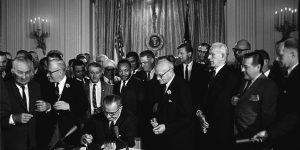What Happened On May 17th?
On May 17, 1954, the U.S. Supreme Court issued a unanimous decision in the case of Brown v. Board of Education of Topeka. This decision declared racial segregation in public schools as unconstitutional.
Delivered by Chief Justice Earl Warren, the ruling stated that “separate educational facilities are inherently unequal,” thus overturning the 1896 Plessy v. Ferguson decision that had established the doctrine of “separate but equal.”
The decision was a leap forward in the fight for equal rights in America, galvanizing the Civil Rights Movement.
The Legal Battle
First off, the dedicated efforts of several organizations challenged the status quo of racial segregation. At the forefront was the National Association for the Advancement of Colored People (NAACP), which orchestrated the legal strategy against school segregation.
One of the most prominent figures in this movement was Thurgood Marshall, the NAACP’s lead attorney. Marshall, who would later become the first African American Supreme Court Justice, was the one who expertly argued the case before the Supreme Court. His legal acumen and commitment to justice were instrumental in securing the victory.
The case was named after Oliver Brown, one of the plaintiffs, who filed the lawsuit on behalf of his daughter, Linda Brown. Linda had been denied entry to an all-white school in Topeka, Kansas, simply because of her race. Brown’s case was combined with similar cases from Delaware, South Carolina, Virginia, and Washington, D.C., highlighting the widespread nature of segregation and discrimination in public schools.

The Supreme Court’s unanimous decision was delivered by Chief Justice Earl Warren. Appointed by President Dwight D. Eisenhower, Warren’s tenure is often remembered for its progressive rulings on civil rights. His leadership and persuasive opinion in Brown v. Board of Education underscored the inherent inequality in segregated schools and set a precedent for future civil rights advancements.
Unknown Brown v. Board of Education Facts
Did you know that psychological research had strong influence on the Court’s decision? The “doll tests” conducted by Drs. Kenneth and Mamie Clark demonstrated the negative psychological effects of segregation on African American children. These studies showed that segregation fostered feelings of inferiority among black children, which significantly influenced the justices’ understanding of the harmful impacts of segregation.
Although the final decision was unanimous, the Supreme Court justices were initially divided on the issue. It took considerable deliberation and the persuasive efforts of Chief Justice Warren to bring all the justices to a consensus. In the end, Warren emphasized the importance of a unanimous decision to send a clear, unequivocal message against segregation.
Despite the ruling, the implementation of desegregation was neither immediate nor easy. The Court’s follow-up decision in 1955, known as Brown II, ordered schools to desegregate “with all deliberate speed.” However, resistance in many Southern states led to delays and, in some cases, violent confrontations. For years, the deep-rooted opposition to desegregation remained strong in the South.
The Broader Impact Of The Decision
The Brown v. Board of Education served as a catalyst for the Civil Rights Movement. It inspired activism that aimed to dismantle segregation and discrimination in other areas of American life. The decision provided a legal foundation for subsequent civil rights legislation, including the Civil Rights Act of 1964 and the Voting Rights Act of 1965.

The Brown decision was a major victory, but the struggle for educational equality continued, intersecting with other moments in the Civil Rights Movement. For instance, a year-and-a-half later on December 1, 1955, Rosa Parks refused to give up her seat to a white person on a Montgomery, Alabama bus.
Her arrest sparked the Montgomery Bus Boycott, a massive protest led by Dr. Martin Luther King Jr., which lasted for over a year and resulted in the desegregation of Montgomery’s public buses.
Dr. Martin Luther King Jr., inspired by the success of the Brown decision, became a central figure in the fight for civil rights. His leadership in nonviolent protests and his eloquent advocacy for justice and equality galvanized the nation.
King’s work, along with the efforts of countless other activists, helped to dismantle segregation and challenge discriminatory practices across the South and beyond. But, when King was murdered in 1968, the fight for racial justice became even more prominent.
However, many schools today remain segregated due to various factors, including residential segregation and disparities in school funding. The legacy of Brown v. Board of Education reminds us of both the progress achieved and the ongoing challenges in the quest for true equality in education.





